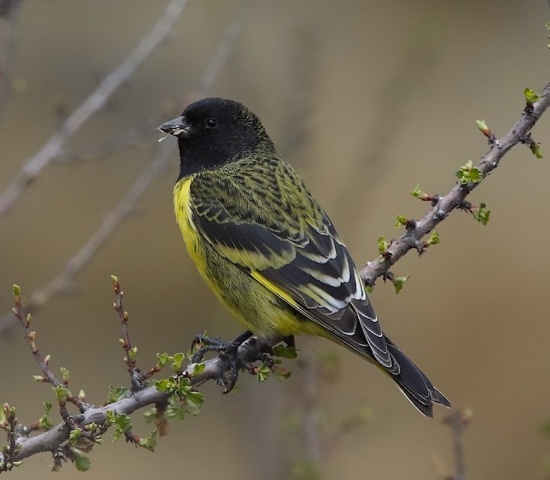
Photo by Stanley Jones
Cordillera Blanca, Huascarán National Park, Pachacotp, Ancash, Peru, August 2017
- Spinus crassirostris
Carduelis crassirostris
Identification
12·5–14 cm (5-5½ in)
- Black head to upper nape and throat
- Yellow wing flashes
Similar Species
Similar to the Hooded Siskin but with stronger bill, and white in the central vent area.
Variation
The northern form (subspecies amadoni) has a less strong bill than crassirostris, but in amadoni, female may be capped
Distribution
South America: found in Peru, Bolivia, Chile and Argentina.
Taxonomy
Formerly placed in genus Carduelis.
Subspecies
Two subspecies[1]:
- S. c. amadoni:
- Andes of south-eastern Peru (Tacna and Puno)
- S. c. crassirostris:
Habitat
Andean steppes, in Polylepis shrubs and scattered woodland. Observed at heights around 4,450 m.
Behaviour
Movements
Partly migratory, southern populations go north in winter.
Diet
Their diet consists almost entirely of Polylepis seeds, buds and shoots during the breeding season. There is little information available outside of this time.
Mostly occur in pairs or small flocks, on ground or in scrub.
References
- Clements, J. F., T. S. Schulenberg, M. J. Iliff, D. Roberson, T. A. Fredericks, B. L. Sullivan, and C. L. Wood. 2017. The eBird/Clements checklist of birds of the world: v2017, with updates to August 2017. Downloaded from http://www.birds.cornell.edu/clementschecklist/download/
- Avibase
- Handbook of the Birds of the World Alive (retrieved Dec 2017)
- BF Member observations
- Wikipedia
Recommended Citation
- BirdForum Opus contributors. (2025) Thick-billed Siskin. In: BirdForum, the forum for wild birds and birding. Retrieved 15 May 2025 from https://www.birdforum.net/opus/Thick-billed_Siskin




